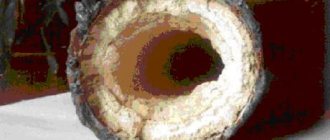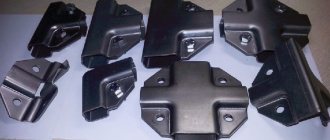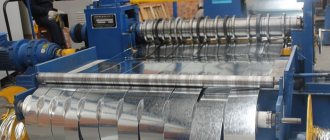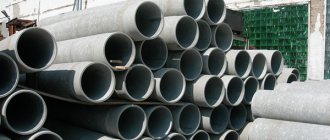If you like something masculine and original, then you are probably a fan of industrial style. Do you want to create a unique flavor in your interior? Make a table from pipes with your own hands, it’s cheap, simple and most importantly, interesting. The essence of the style is structures made of metal, wood, plastic in various combinations. Of course, there are amazing models that cost a lot of money, but if you approach the matter without fanaticism, you can make a very nice table in the industrial style, for example, from water pipes. The material is cheap, you can choose any size you like, and everyone can work with a wrench.
You can use different pipes - profile, plastic - depending on your taste and tools. This article presents thirty examples with step-by-step photo instructions, I hope it will be enough for inspiration.
Connections at the top
Take a 43 cm piece of pipe. Glue the corners on both sides.
Make another one like this. Place the paired parts made at the previous stage vertically. Connect the right post with the first one to the left post with the second fabricated part with corners. Connect the posts on the other side with the second piece.
Paint the resulting structure and dry it. You can paint PVC, for example, with acrylic paint. In this case, it is better to use the aerosol version. In this case, the paint will lie smoother. But you can, of course, take a regular brush for painting.
Natalia Krachkovskaya's future husband won her heart with the help of fresh buns
Things with animal print - trend 2021: what should be in the wardrobe
“I leave personal and difficult things behind the scenes”: Fedunkiv spoke about creative plans
Apply paint to the cabinet frame in several layers. Your closet rack is almost ready. Now we need to make shelves for it.
Assembly of the structure
In order for the installation process to be simple and not cause much trouble, it is important to draw up an order or, better yet, a diagram for assembling the product. You can do this yourself, but the option of using one or another type of furniture made from standard materials as a sample is also suitable. In addition, there are special construction publications devoted to this topic. The assembly diagram and even drawings are taken from there. Taking a sample of classic furniture as a basis, it is recommended to take into account the properties and characteristics of plumbing systems.
You should start working with pipes with simple products, like shelves. With experience comes skills, and the task becomes more difficult. The variety of options is limitless and depends on the desire and imagination of the author. The reward will be the uniqueness of the piece of furniture and the knowledge that it was created with your own hands.
How to glue tees
It is very easy to glue fittings - tees, angles - to pipe sections. The technology is as follows. Take a tee and coat the walls inside the pipe to which you plan to glue the pipe. Also lubricate the end of the pipe. Insert the pipe into the fitting. Remove excess glue with a paper towel.
A motivating phrase that helps you forget about the clutter in your home
Sunken ships and other beautiful photos of the winners of the underwater competition
New maintenance rules postponed: what Russians need to be prepared for from March 1
Material cutting
Take PVC pipes and cut them into 12 lengths of 45 cm, six lengths of 30 cm, two lengths of 43 cm. When cutting pipes, use a tape measure and a ruler and a pencil. The appearance of your cabinet will depend on how accurately you cut. You can choose other sizes, depending on the size of the rack you want to get as a result.
The “California” strain of coronavirus frightened American scientists
Bill Gates and calcium carbonate are to blame: why do bloggers burn with snow?
Goat invasion: residents of a British resort tolerate mountain animals (photo)
Take pine boards. Cut a piece 370 cm long. Saw it into 3 equal parts. If you cannot find a 60 cm board, you can use a 30 cm board. In this case, you will need to cut two pieces of 370 cm and saw each of them into 3 parts. In this case, the shelves will be prefabricated - double.
How to make a closet (wardrobe) for things with your own hands at home
So, the family council has adopted the design decision, and you are ready to begin its implementation. Please keep in mind that the result meets your expectations; you have no right to make mistakes.
Advice! Take measurements several times, check everything thoroughly and only then start cutting. In furniture production, even inaccuracies of 1-2 mm can lead to the fact that the workpiece will have to be made again. And this is additional expenses.
How to do everything accurately and competently, read below.
Criteria for choosing a product design during manufacturing
Furniture factories have modern, high-quality raw materials in their arsenal. Various designs, textures, and prices allow us to satisfy the needs of the most demanding customers. At the same time, experts recommend that when choosing a material, you should be guided not only by its price and external characteristics, but by quality and reliability. In this case, the furniture will last a long time, and the costs are justified. Here is an overview of popular materials from which you can make a cabinet with your own hands.
The most budget material - therefore it is in high demand among the population. Chipboard is made from the remains of wood species. Using special equipment, the raw materials are brought to the state of chips, after which they are impregnated with a resin mixture.
- unlimited forms, textures;
- huge palette of colors;
- multifunctionality;
- the material is easy to combine with the interior style. A do-it-yourself wardrobe made from chipboard will fit into every home;
- low price.
- afraid of moisture;
- The service life of furniture made from chipboard is much shorter than that made from more expensive materials.
It is analogous to the panels discussed above - with the only difference that the laminated chipboard version undergoes final surface lamination. This increases the wear resistance of raw materials and improves the appearance of the product.
The most popular material. Combines the price-quality principle. MDF is based on the same waste wood, reduced to a fine fraction. Moreover, their strength is 2 times higher than chipboard.
- not afraid of moisture;
- resistant to steam;
- has a perfectly smooth surface;
- with high strength it is a fairly flexible material. This gives scope for creative imagination and allows you to make concave pieces of furniture.
- raw materials are classified as fire hazardous;
- afraid of mechanical damage.
When it comes to a wardrobe, MDF is the best solution. Does not cause allergies. The special glue that is used when gluing the panels is completely safe for the human body.
Tree
Natural solid wood is an ideal material for furniture production. Has the following advantages:
- looks solid;
- environmentally friendly;
- has excellent natural characteristics;
- has a long service life.
The disadvantage is the high price.
Natural wood is used for the production of cabinet sides, lower and upper shelves. Less commonly, facades and doors are made from them.
Veneer is a special panel, the basis of which is MDF or chipboard. The surface of the panel is covered with a thin wooden film. The material is not cheap; raw materials are used in the production of luxury furniture models. As a rule, these are individual orders and design solutions.
- quality;
- reliability;
- looks like a tree;
- durability.
How to make drawings, where you can get ready-made ones
A drawing is an important step in making a wardrobe with your own hands. The final result depends on how correctly it is done. Keep in mind that it is very difficult to correct inaccuracies and errors after cutting furniture elements.
Start small. Choose a design, decide on the configuration. Think about the internal content in advance. Proper zoning of the interior space of the cabinet will improve its functionality.
Measure the room where the closet will be placed. If there is a niche between the walls, use this space to your advantage. Decide what depth you need. Consider the type of design:
- built-in;
- hull
Take into account all the elements - the dimensions of the facades, decorative fragments, fittings.
Transfer the drawing to paper. An alternative is special programs on the Internet.
When there is no ready-made solution, look at what thematic sites offer.
Advice! If you are not confident in your abilities, choose simple models. Complex designs require certain assembly skills.
Step-by-step instructions for making cabinets
The algorithm for self-assembling a standard cabinet includes several stages:
- Make preparations. Prepare the material you have chosen. Mark it with measurements and start cutting. If you do not have the experience or the necessary tools, entrust this task to professionals. For little money, you will get the most accurate cutting of all structural elements. Note! To do this at home, you will need a workbench or at least a countertop. After cutting, sand all edges with sandpaper. There should be no chips, burrs, or small cracks;
- Assemble the frame. If you make a built-in option, the process will be much simpler, since several pieces of furniture will replace the walls of the room. They are pre-aligned, painted or wallpapered. Mount the parts according to the diagram - first the internal contents, last - the doors. If you are assembling a cabinet structure, first drill all the holes. Then, attach the bottom to the side panels. The next step is to install the roof. And only after you have a frame, secure the back wall;
- Install shelves. Apply markings to the inside of the panels. Install partitions over them. Attention! Make sure they stand strictly vertical. Install shelf fasteners. Lay out guides for drawers. Lastly, hang hooks, rods, and fittings.
- Install doors. If you have a coupe, install the top rail first, then the bottom rail. If they do not lie horizontally, the doors will not fit. Install stops and roller mechanisms. Place the facades into the gutters until you hear a slight click. Do not press too hard, otherwise you will damage the mechanism. Hinged facades are attached to the elements using self-tapping screws and the absence of distortions, overlap or friction is checked.
A simple budget cabinet made from scrap materials
Try building a small pantry cabinet. For example, from a rack.
Decide on the dimensions of the product and draw up a drawing.
The standard rack has a simple design. It consists of shelves and a frame. To create a cabinet, all you have to do is hang doors on it.
Calculate the dimensions of future doors, decide on the method of fastening.
As a raw material, take laminated chipboard panels - a budget and practical material. Buy the hinges and start assembling:
- To secure the back wall, a screwdriver and a hammer are enough;
- if you have quick-installation hinges, there is no need to create a gap in the door, unlike standard fasteners;
- mark with a pencil the locations of their placement;
- Screw the screws into the wider holes first - this makes it easier to adjust the position of the door. Only after placing the rack vertically and making sure that the door is installed level, screw in the remaining two screws.
Advice! If the cabinet is tall and narrow, for better stability, secure it to the wall using two corners.
Hinged wardrobe with doors
To assemble a wardrobe with swing doors yourself, make a drawing or use a ready-made diagram. Further:
- collect the cabinet fragments. If possible, have the pieces cut at a furniture company. All components will be prepared for you according to individual sizes;
- Mark where the holes will be located and drill the holes. Work with a confirmat drill;
- secure furniture supports. Control the perpendicular with a square. To fix the legs, use self-tapping screws;
- draw the internal markings. Make holes in the shelves and ends of the racks;
- connect the elements together. Important! Assemble the structure in a horizontal position;
- attach the doors. Use a jig - this ensures their correct location. Align the facades and secure them.
Wardrobe with shelves
If you plan to make furniture with shelves of various sizes, you cannot do without a special program. It generates a specification for sawing all the elements of the structure for its further assembly.
Make the markings for fixation yourself. All you need is the ability to think spatially.
The addition of elements is important. If everything is done accurately, the furniture will be assembled quickly and easily.
Instructions for assembling a cabinet with shelves with your own hands:
- prepare the details;
- connect the bottom and sides;
- fix the roof;
- screw the base;
- screw the legs or thrust bearings;
- install stiffeners;
- install shelves;
- attach the back wall;
- place the product vertically and move it to its destination;
- install the doors.
The model shown in the figure can be easily assembled yourself. For more complex designs you will need help.
Open wall cabinet
Step-by-step instructions for assembling a wall cabinet with your own hands:
- assemble the frame - use chipboard panels;
- fix the rear support wall;
- install the front frame on the façade of the structure;
- insert internal shelves.
Examples of open cabinet options with wall mounting:
More complex design:
List of tools
Keep in mind that to make even a small cabinet with your own hands, you will need an impressive list of tools. They are grouped by categories.
At all stages of production it is impossible to do without measuring instruments. These include:
- pencil;
- marker;
- ruler;
- roulette;
- level;
- furniture templates - they are sold ready-made in construction stores.
Devices for cutting and edging surfaces:
- jigsaw for wood and a set of files;
- router for edge removal;
- grinding apparatus;
- construction hairdryer As a last resort - an iron;
- a set of sandpaper;
- sealant, wax, corrector for surface restoration.
Tool for assembling components of a future product:
- drill;
- vice;
- hammer;
- mallet;
- screwdriver;
- screwdriver set;
- perforator;
- extension;
- hacksaw or metal scissors;
- hand tools - files, chisels, pliers, wrenches.
Note! In addition to a set of tools, high-quality assembly is impossible without an equipped workplace. If it is not there, transfer all difficult stages to the workshop.











